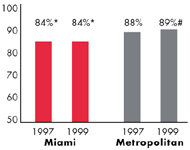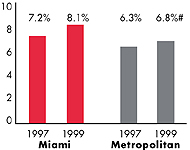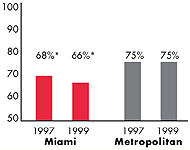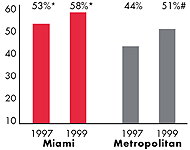Community Report No. 10
Summer 2001
Glen P. Mays, Sally Trude, Lawrence P. Casalino, Patricia Lichiello, Ashley C. Short, Andrea Staiti
| Miami Demographics |
| Miami County |
Metropolitan areas above 200,000 population |
Population, July 1, 19991
2,175,634 |
| Population Change, 1990-19992
|
| 12% |
8.6% |
| Median Income3 |
| $19,672 |
$27,843 |
| Persons Living in Poverty3 |
| 25% |
14% |
| Persons Age 65 or Older3 |
| 15% |
11% |
Sources:
1. US Bureau of Census, 1999 Community Population Estimates
2. US Bureau of Census, 1990 & 1999 Community Population Estimates
3. Community Tracking Study Household Survey, 1998-1999 |
| Health System Characteristics |
| Miami |
Metropolitan areas above 200,000 population |
| Staffed Hospital Beds per 1,000 Population1
|
| 3.6 |
2.8 |
| Physicians per 1,000 Population2
|
| 2.7 |
2.3 |
| HMO Penetration, 19973 |
| 64% |
32% |
| HMO Penetration, 19994 |
| 52% |
36% |
Sources:
1. American Hospital Association, 1998
2. Area Resource File, 1998 (includes nonfederal, patient care physicians,
except radiologists, pathologists and anesthesiologists)
3. InterStudy Competitive Edge 8.1
4. InterStudy Competitive Edge 10.1 |





